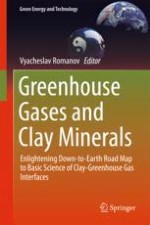This book is a systematic compilation of the most recent body of knowledge in the rapidly developing research area of greenhouse gas interaction with clay systems. Unexpected results of the most recent studies – such as unusually high sorption capacity and sorption hysteresis of swelling clays –stimulated theoretical activity in this fascinating field. Classical molecular dynamics (MD) explains swelling caused by intercalation of water molecules and to a certain degree of CO2 molecules in clay interlayer. However, unusual frequency shifts in the transient infrared fingerprints of the intercalated molecules and the following accelerated carbonation can be tackled only via quantum mechanical modeling. This book provides a streamlined (from simple to complex) guide to the most advanced research efforts in this field.
